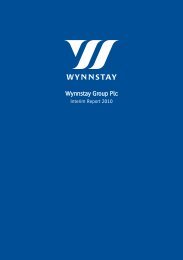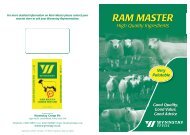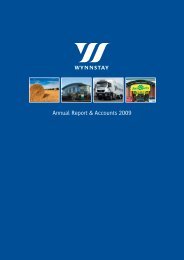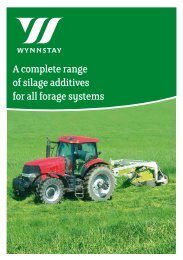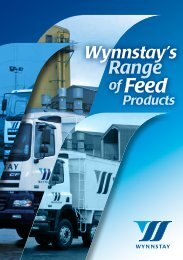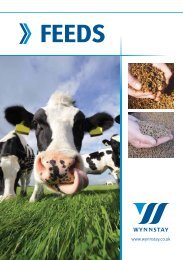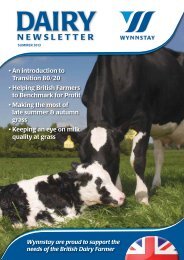Dairy
N e w s l e t t e r - Wynnstay
N e w s l e t t e r - Wynnstay
- No tags were found...
You also want an ePaper? Increase the reach of your titles
YUMPU automatically turns print PDFs into web optimized ePapers that Google loves.
TEstimonial:<br />
Commercial Unit- 38kW System<br />
Martin Evans, Llangedwyn, Powys - <strong>Dairy</strong> Unit<br />
Martin Evans, a <strong>Dairy</strong> Farmer from Llangedwyn, Powys<br />
invested in a solar PV system from Wynnstay for energy<br />
savings on his farm in February 2012.<br />
He opted for a 38kW £65,000 system purchased through<br />
Wynnstay and fitted by D Jones Electrical.<br />
The system earns 34.5p per kW/h under the FIT’s scheme,<br />
this has amounted to an income of £12,000 between<br />
March and October, a monthly income of around £1,500.<br />
Martin has also been able to use the electricity generate<br />
for his own needs as well as receiving the feed in tariff<br />
payments. The panels, along with the introduction of a<br />
new milking parlour have allowed Martin to reduce his<br />
electricity bill by just under £500 a month, reducing it from<br />
£1,100 to £600.<br />
‘I was very keen to invest in Solar PV panels to make<br />
savings on the amount of electricity the farm uses, as well<br />
as benefiting from the feed in tariff income. The service<br />
received from the installer was very good and I would<br />
definitely recommend to others.’ Mr Evans commented.<br />
Solar PV- Taxation Considerations<br />
There is a degree of miss information in the public domain regarding solar<br />
panels and taxation. The gravest of these is that the receipts are tax free by<br />
their very nature. This is not necessarily the case and, as with any project,<br />
there are a multitude of considerations. The following highlights some of the<br />
key taxation issues.<br />
Broadly speaking, for solar panels to qualify for a domestic Feed in Tariff (FIT)<br />
which is exempt from income tax the following criteria need to be met:<br />
1. system capacity less than 50Kw; and<br />
2. is installed by an individual at or near their home; and<br />
3. they do not intend the system to produce electricity that will significantly<br />
exceed the electricity used at the dwelling (HMRC consider 20% to be<br />
significant in this case); and<br />
4. the FIT is received in a private capacity i.e. not bought in the business<br />
name, not used for business purposes nor advertised as part of the business.<br />
The downside to treating the FIT as a qualifying domestic system is that there<br />
is no tax relief available on the capital cost of the installation. In addition none<br />
of the input VAT (reduced rate of 5%) on the capital cost of the installation is<br />
able to be reclaimed as no business is being carried out.<br />
Where a business installs a solar panel system, any income from the system<br />
will be treated as a business receipt and will be taxed as such. However tax<br />
relief is available on the capital cost of the installation.<br />
For businesses, tax relief on the capital cost of the installation is given in the<br />
form of capital allowances. The rate at which relief is given varies from 0%<br />
for buildings right up to 100% for qualifying plant and machinery. Providing<br />
the business qualifies to claim Annual Investment Allowance (AIA), 100%<br />
tax relief will be available on the qualifying plant and machinery costs of<br />
installing the solar panels up to the AIA limit.<br />
For two years from 1 January 2013, the annual ceiling on AIAs has been<br />
increased from £25,000 to £250,000. Special transitional rules apply where<br />
the business’s accounting date is other than 31 December. For example, if<br />
the accounting date is 31 March, the maximum qualifying expenditure for the<br />
whole of the year to 31 March 2013 will be £81,250 of which only £25,000<br />
may be spent before 1 January 2013. To the extent that the expenditure<br />
exceeds the business’s available AIA, the qualifying plant and machinery will<br />
qualify for a tax writing down allowance of 8% per annum (post April 2012<br />
expenditure).<br />
Input VAT (standard rate of 20%) on the capital cost of the solar panel<br />
installation will also be reclaimable subject to the usual rules. In particular<br />
any private use of the electricity generated by the system will need to be<br />
considered on a case by case basis. There is no output VAT on FITs received<br />
by the business as these are outside the scope of VAT. However, where export<br />
tariff receipts are received by a business, these are subject to output VAT at<br />
20%.<br />
Whittingham Riddell LLP Chartered Accountants have extensive experience of<br />
advising clients within the agricultural sector. Please contact Graham Murphy<br />
on 01686 626230 if you have a query you would like to discuss.<br />
Graham Murphy BA FCA<br />
Partner at Whittingham Riddell LLP Chartered Accountants<br />
www.whittinghamriddell.co.uk<br />
Wynnstay are working in collaboration with D Jones Electrical Contractors to offer a range of renewable solutions to both agricultural<br />
and domestic customers. For more information on solar PV and other renewable products please call 01691 662690.<br />
Wynnstay Group Plc <strong>Dairy</strong> Newsletter Spring 2013 19



